Hole in the Clouds
Sep 11, 2009
The Great Lakes are basically big puddles that filled with meltwater after the last Ice Age; to this day, almost all the rivers that feed the lakes come in from the north, where the glaciers used to be.
We could think of the Great Lakes as five bowls set on a staircase, each bowl brimming over and cascading down into the next. By the time the water slops over from the fourth bowl--Lake Erie--down to the last one--Lake Ontario--it's really spilling seriously, all fast and furious. And so we have Niagara Falls: an entire Ice Age of fossil water, draining down through four Great Lakes and then crashing hard through a narrow little riverbed to splash into that one last lake and then the St. Lawrence River and finally the Atlantic Ocean.
When European explorers first glimpsed Niagara, its connection to the two huge lakes seemed obvious and dramatic. This 1837 bird's eye view puts Lake Erie at the top, the falls in the middle, and Lake Ontario at the bottom of the picture, collecting all that splashover from ten thousand years of melting ice.

New York
Niagara Falls
Lake Ontario
Lake Erie
ice age
Canada
(Image credit: W.R. Callington)
Sep 14, 2009
I know nothing about this picture, except that photographer Geoff MacIntosh, of Calgary, Alberta, titled it "Grin."

Canada
Calgary
(Image credit: Geoff MacIntosh)
Aug 17, 2009
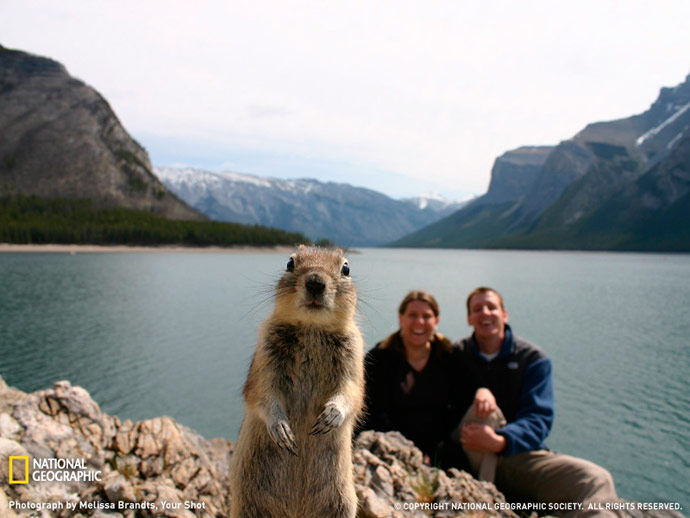
They wanted a picture of themselves at their lakeside campsite in Banff National Park, so they put the camera on a rock and set the shutter for a delayed snapshot.
The whirring sound made by the camera as it prepared to snap attracted a squirrel, who chattered right back at it and got himself nicely pixellated for his 1/250th of a second of fame.
Or so it said on the National Geographic website. Hat tip to John "J.J." Stein for this fine submission to our irregular summer series of cute animal pictures. (Yes, there are more....)
animal
John Stein
Canada
squirrel
Banff National Park
(Image credit: National Geograpic)
Oct 18, 2009

The goalkeeper for Toronto FC, an MLS team, plays almost in the shadow of the city's CN Tower.
sports
soccer
Canada
Toronto
CN tower
(Image credit: Sam Javanrouh)
Nov 19, 2009
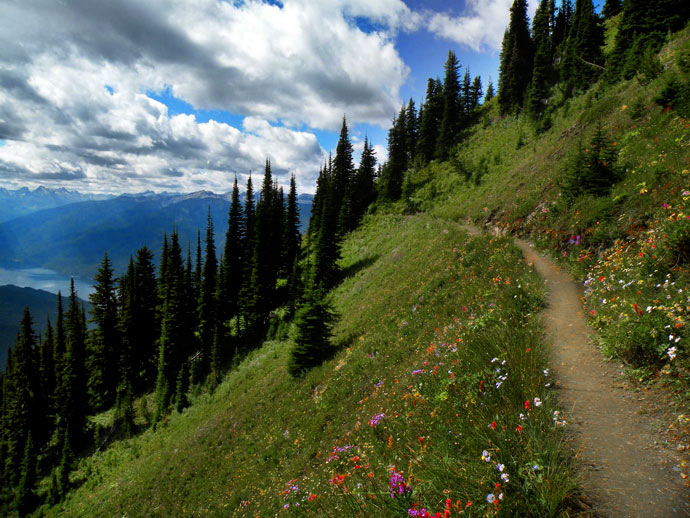
About twelve summers ago, we made it to Idaho Peak, above New Denver, British Columbia, in the Selkirk Mountains. That meadowful of flowers up there is as good as it gets for flowers.
The trail isn't as sketchy as it might look; it meanders gently around the bend up ahead toward a fire tower that overlooks Slocan Lake and the tiny lakeside towns of Silverton and New Denver. All the settlements in this neck of the woods were late-nineteenth-century mining towns; when the silver and gold gave out in the early to middle years of the twentieth century, the towns struggled, and some vanished. A revival began in the 1960s with U.S. draft dodgers and Canadian and U.S. back-to-the-landers, who were attracted by the scenery and the lack of twentieth-century sprawl.
Best thing about the flowers on Idaho Peak: it's always summer up there. The flowers are always in full bloom. I can't remember it any other way.
landscape
Canada
mountains
summer
Idaho Peak
New Denver
British Columbia
Slocan Lake
flowers
(Image credit: Z Vickery)
Dec 20, 2009

The poor bicycle, chained to a pole, had no chance to escape. But at least nobody was riding it at the time.
Photo by Sam Javanrouh in Toronto.
Canada
Toronto
bicycle
tree
city street
(Image credit: Sam Javanrouh)
Mar 11, 2010

A shaft of sunlight has slipped between a couple of skyscrapers to illuminate this woman's walk across King Street in Toronto.
Canada
Toronto
streetscape
Ontario
(Image credit: Sam Javanrouh)
Jun 27, 2010
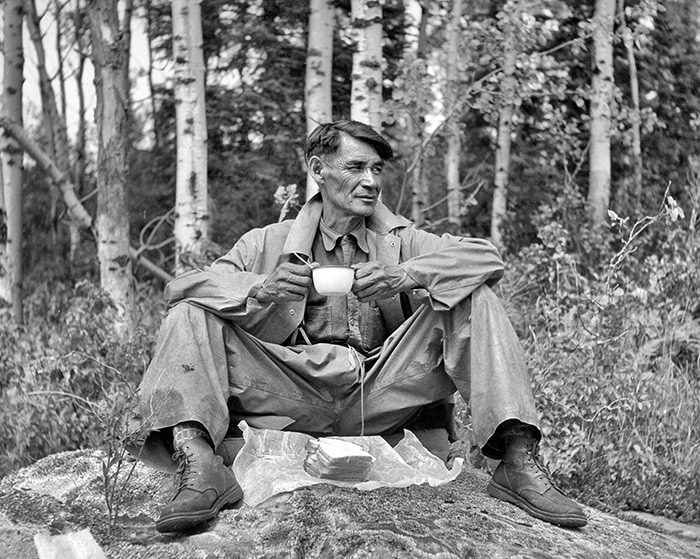
A man identified as "Canadian fishing guide" breaks for lunch on the shores of Lake of the Woods, Ontario, in 1952.
vintage
Canada
Ontario
Lake of the Woods
Aug 6, 2010

Back alley in downtown Toronto, Ontario.
Canada
Toronto
streetscape
windows
(Image credit: Sam Javanrouh)
Oct 24, 2010
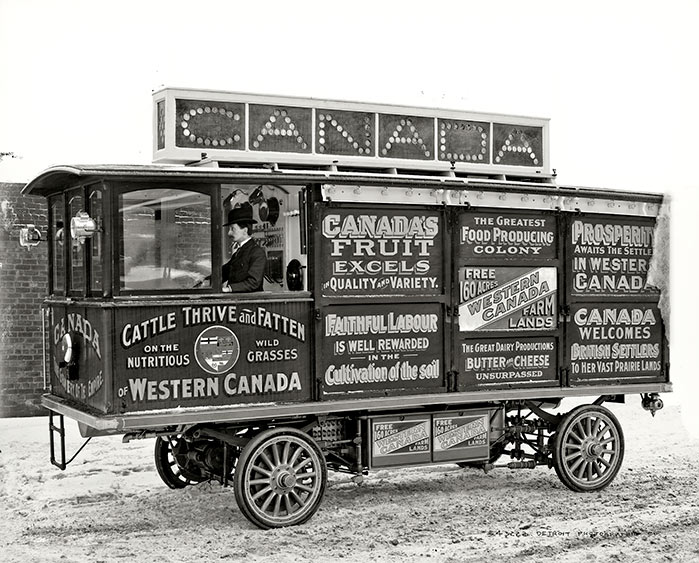
The stereotypical Canadian self-effacement apparently did not play a large part in 1905 in the design of this vehicle, a joint venture between the Canadian Pacific Railway and the governments of the brand new provinces of Alberta and Saskatchewan.
The motor car was intended to travel the byways of England, promoting immigration to western Canada and, perhaps incidentally, ticket sales on the Canadian Pacific Railway and its trans-Atlantic steamship subsidiary.
The promotional message left out a few details. For one thing, although homesteaders could indeed claim 160 free acres of land, it cost $10 to file the claim, a sum many would-be homesteaders could not come up with after paying the Canadian Pacific for steamship and railway passage. Also, in the, um, bracing climate of the Canadian prairies, 160 acres was not nearly enough land to support a family.
So although the promotional efforts succeeded quickly in populating the prairies--this round of Canadian homesteading was closed off by 1914--most of the homesteaders were ultimately unsuccessful at farming and ranching. Among those few who could stick it out long enough to prove up on their claims, drought years beginning in 1920 ultimately chased them away. Today the Canadian prairie provinces (like the U.S. prairie states) are littered with ghost towns and empty farmhouses.
The vehicle pictured here was a hybrid, powered by electric motors at each wheel and a gas engine that heated a steam boiler. It never did work properly and was abandoned in London.
vintage
Canada
Canadian Pacific Railway
hybrid vehicle
Manitoba
Saskatchewan
1905
(Image credit: via Shorpy)
Nov 3, 2010
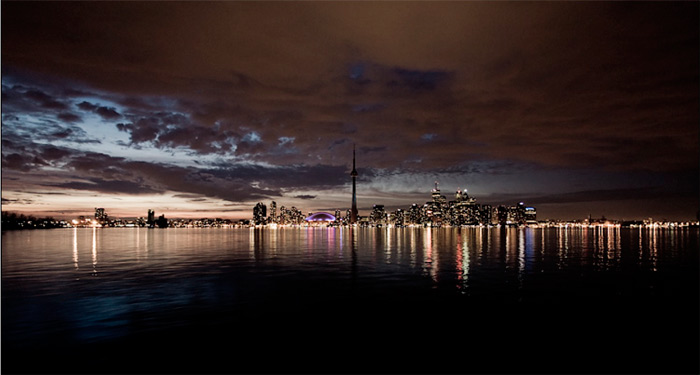
Sam Javanrouh's caption for his nighttime skyline shot was indeed a reference to election results--but not to the mid-term elections at the center of the media universe here in the U.S.
Javanrouh was unhappy about last week's mayoral election in Canada's largest city, Toronto, where a "right-wing intolerant redneck" named Rob Ford trounced former deputy premier of Ontario George Smitherman. Ford ran openly homophobic ads against Smitherman, who is openly gay. He also promised to cut taxes and stop spending and etc.
The CN tower is dark in this photo, not its usually well-lit self, but that's just a coincidence, not an example of early budget-slashing. Must be Obama's fault.
Canada
cityscape
night
Toronto
Ontario
Rob Ford
George Smitherman
skyline
(Image credit: Sam Javanrouh)
Apr 22, 2011
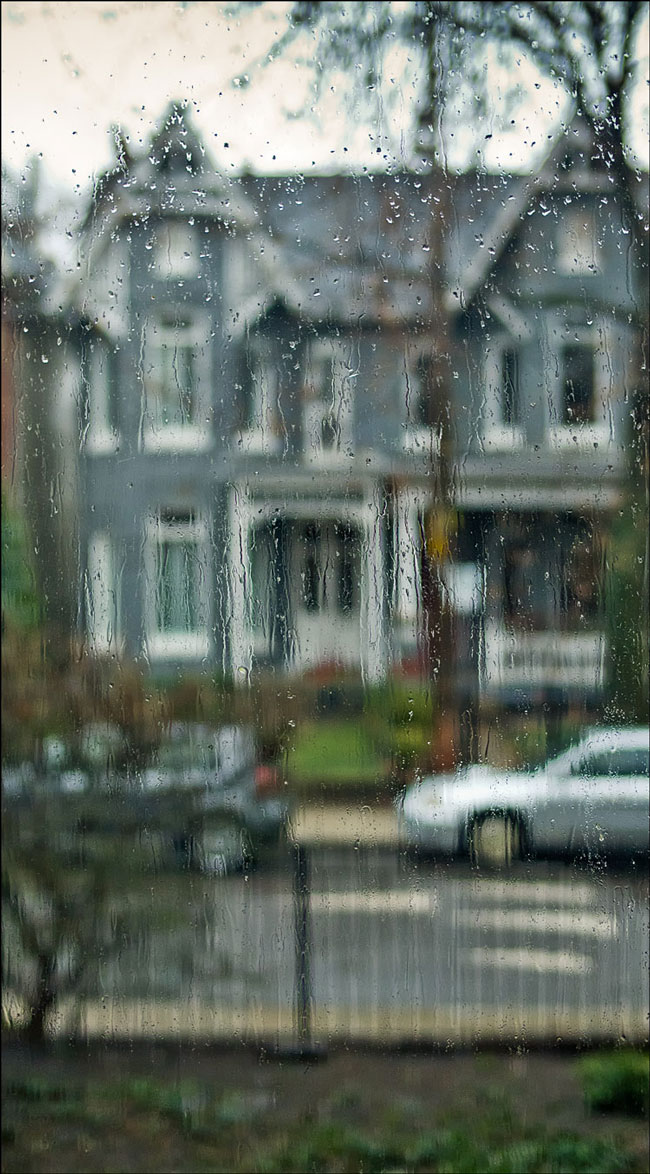
This windowful of April is in Toronto. Let the May begin.....
Canada
Toronto
streetscape
spring
window
(Image credit: Sam Javanrouh, via Daily Dose of Imagery)
May 5, 2011
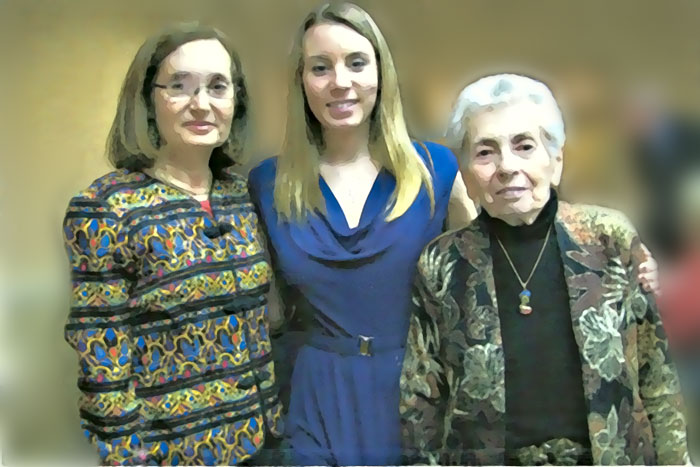 Here we see yet another branch of the family, a cast of characters with international flair: my cousin Susan, at left, who lives near Toronto, Ontario; her daughter Erica, who is working on her doctorate in archaeology at Oxford University in England; and Susan's mother Ethel, who lives in Annapolis, Maryland.
Here we see yet another branch of the family, a cast of characters with international flair: my cousin Susan, at left, who lives near Toronto, Ontario; her daughter Erica, who is working on her doctorate in archaeology at Oxford University in England; and Susan's mother Ethel, who lives in Annapolis, Maryland.
Erica's research at Oxford focuses on what people ate in antiquity. She collects seeds and other plant materials from archaeological digs in the Middle East and and analyzes them in the lab to learn about their role in ancient diets.
This picture was taken a few months ago at Ethel's ninetieth birthday celebration. She is a young and active ninety, taking after her mother, who lived to be a young and active one hundred.
Annapolis
Canada
family
cousins
Susan Rowan
Erica Rowan
Ethel Bergstein
Jun 23, 2011
 Believe it or not, yesterday was Go Skateboard Day in Toronto, where this fella was truckin on down College Street.
Believe it or not, yesterday was Go Skateboard Day in Toronto, where this fella was truckin on down College Street.
sports
Canada
Toronto
streetscape
Ontario
skateboard
(Image credit: Sam Javanrouh)
Aug 16, 2011
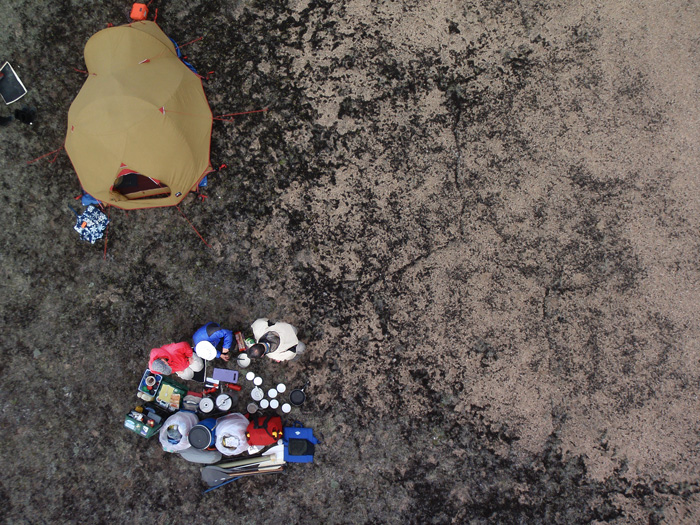 "Lee, Brian & Jeff making dinner," notes photographer Rich Durant, who snapped the picture of the men at their campsite along the Lorillard River in Nunavut. The Lorillard flows across tundra and bare rock of the billion-year-old Canadian Shield to enter Hudson Bay near the latitude of the Arctic Circle.
"Lee, Brian & Jeff making dinner," notes photographer Rich Durant, who snapped the picture of the men at their campsite along the Lorillard River in Nunavut. The Lorillard flows across tundra and bare rock of the billion-year-old Canadian Shield to enter Hudson Bay near the latitude of the Arctic Circle.
Where was Rich standing when he took this shot? It doesn't really matter; he had flown the camera up into the sky by hanging it from a kite and was using a remote control mechanism to operate the shutter while remaining safely on the ground.
The men were canoeing down the whitewater of the Lorillard; as you can see, they had stowed their gear in drysacks and waterproof boxes. The sacks and boxes don't look particularly bear-proof, however, and it's not clear what kind of arrangements they might be making to keep their food away from bears and other critters.
Whatever they were doing, it apparently didn't work out too well. The pictorial record of the expedition–called "Lorillard River Briefly"–includes photos (taken from the ground) of wolf tracks and big white bears, and then . . . a tent and foodsack trashed by something big and hungry.
Canada
aerial view
birdseye view
rock
Lorillard River
Nunavut
kite
(Image credit: Rich Durant)
Oct 17, 2011
 Very rarely do these Good Mornings feature movie stars and suchlike. So here's something different for y'all, a real celebrity, in a photo taken by Sam Javanrouh at last month's Toronto International Film Festival.
Very rarely do these Good Mornings feature movie stars and suchlike. So here's something different for y'all, a real celebrity, in a photo taken by Sam Javanrouh at last month's Toronto International Film Festival.
Canada
Celebrity
movie star
Toronto International Film Festival
(Image credit: Sam Javanrouh)
Mar 10, 2012
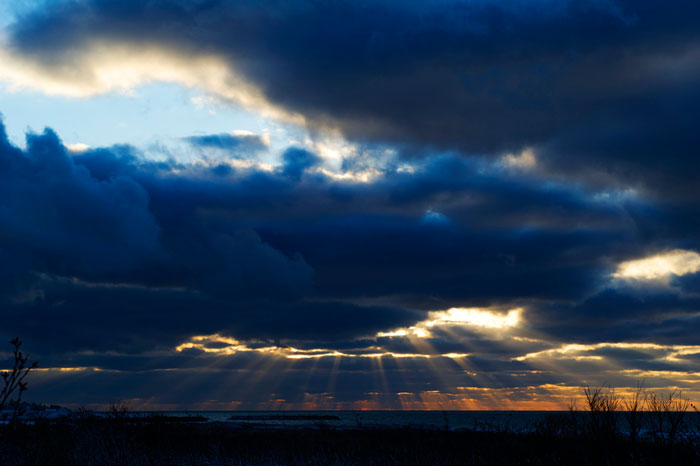 Sunbeams break through gaps in dark clouds after an intense snow squall in Port Maitland, Nova Scotia. This is the sort of astronomical phenomenon that used to be used in ads for gospel albums by singers who are no longer with us, but it can occur any time that thick clouds blocking the sun get a little raggedy, most notably when the sun is low in the sky. This photo was taken 45 minutes before sunset last January 30.
Sunbeams break through gaps in dark clouds after an intense snow squall in Port Maitland, Nova Scotia. This is the sort of astronomical phenomenon that used to be used in ads for gospel albums by singers who are no longer with us, but it can occur any time that thick clouds blocking the sun get a little raggedy, most notably when the sun is low in the sky. This photo was taken 45 minutes before sunset last January 30.
Canada
sunset
winter
clouds
skyscape
Port Maitland
Nova Scotia
(Image credit: Bill Curry)
Jul 5, 2012
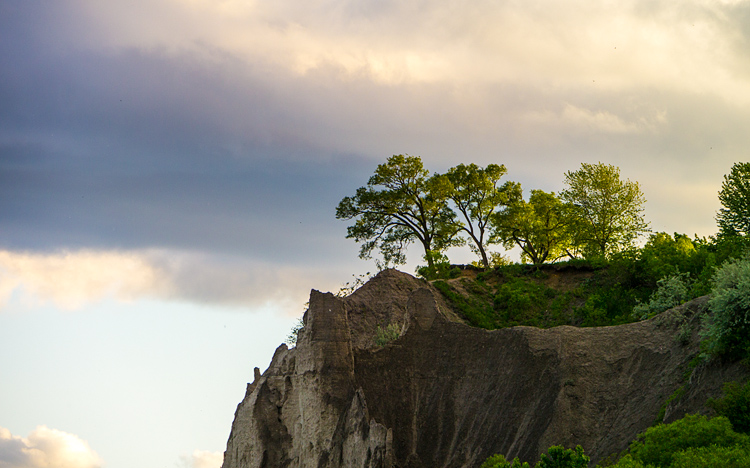 Scarborough Bluffs escarpment above Lake Ontario in Toronto.
Scarborough Bluffs escarpment above Lake Ontario in Toronto.
Lake Ontario
Canada
summer
Toronto
Scarborough Bluffs
escarpment
(Image credit: Sam Javanrouh)
Aug 18, 2012
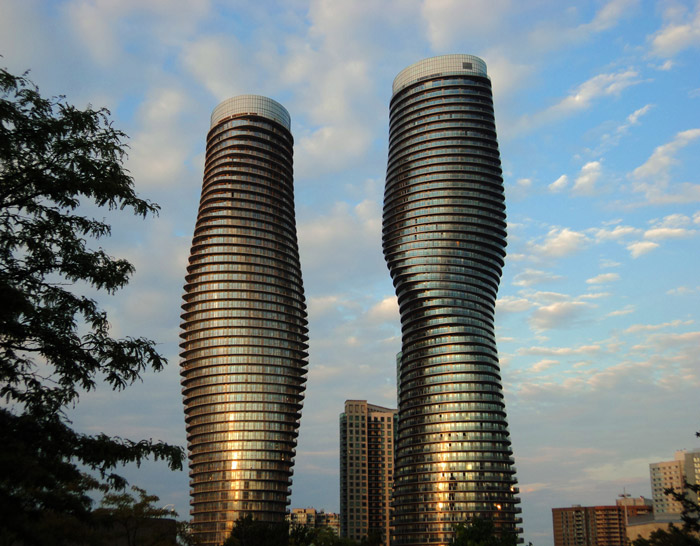 Just west of Toronto, in the fast-growing suburban city of Mississauga, these two condo towers have scratched the sky in flat-out defiance of latter-day suburban trends: they are not boxy, they are not real-estate development disasters, and not a one of their 800-plus condo units is exactly like any other in size or shape.
Just west of Toronto, in the fast-growing suburban city of Mississauga, these two condo towers have scratched the sky in flat-out defiance of latter-day suburban trends: they are not boxy, they are not real-estate development disasters, and not a one of their 800-plus condo units is exactly like any other in size or shape.
In 2005, Mississauga's mayor announced an international design competition for a single 54-story tower at the site, to be known as Absolute World. In 2007, the winning architect was announced, chosen by the voting public from among six finalists selected by a panel of Canada's leading architects and planners. The winner was Yasong Ma, of MAD Architectural Design Studio in Beijing. Almost immediately, the spiraling, curvaceous tower was nicknamed Marilyn Monroe.
When condominiums in Marilyn Monroe were offered for pre-construction sale, almost all were under contract within 24 hours. The developers quickly announced a second, companion tower, also spiraling and asymmetric but a bit more buxom, so as to accommodate a few more units. This second tower sold out within about a month.
People began moving into Marilyn Monroe, the righthand tower in this picture, in July 2011. Both towers are now fully occupied. They feature six stories of underground garage space and are located across the street from one of the largest shopping malls in North America.
Canada
cityscape
Ontario
skyscrapers
Marilyn Monroe
towers
Mississauga
Oct 24, 2012
 Almost nothing is known about this photo, which apparently showed up recently in a secondhand store in Vancouver, British Columbia.
Almost nothing is known about this photo, which apparently showed up recently in a secondhand store in Vancouver, British Columbia.
Dominion Photo Company, which takes credit for the picture, operated in Vancouver for about fifty years, beginning in 1914. The fashions on display here, in clothing and music, not to mention the light fixtures and potted palms, suggest the 1930s?
We would imagine that when all those dozens of lap guitars got to strumming, the sound of the islands would have really filled up a room. Thanks to the magic of YouTube, master slide guitarist Johnny Pal shows how it was done.
Canada
music
British Columbia
Vancouver
1930s?
ballroom
guitars
Hawaiian music
(Image credit: Dominion Photo Co., via Shorpy)
Feb 7, 2013
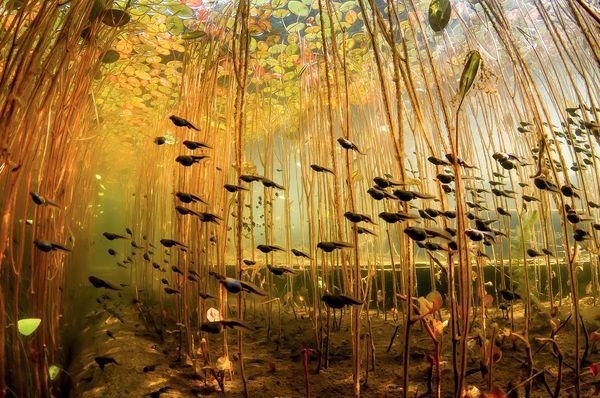 Tadpoles swarm amongst the lily stalks in a Canadian pond, in a photo submitted to National Geographic by Campbell River underwater photographer Eiko Jones.
Tadpoles swarm amongst the lily stalks in a Canadian pond, in a photo submitted to National Geographic by Campbell River underwater photographer Eiko Jones.
Canada
British Columbia
waterscape
pond
tadpoles
Campbell River
lily pond
underwater
(Image credit: Eiko Jones via NatGeo)
Jun 27, 2013
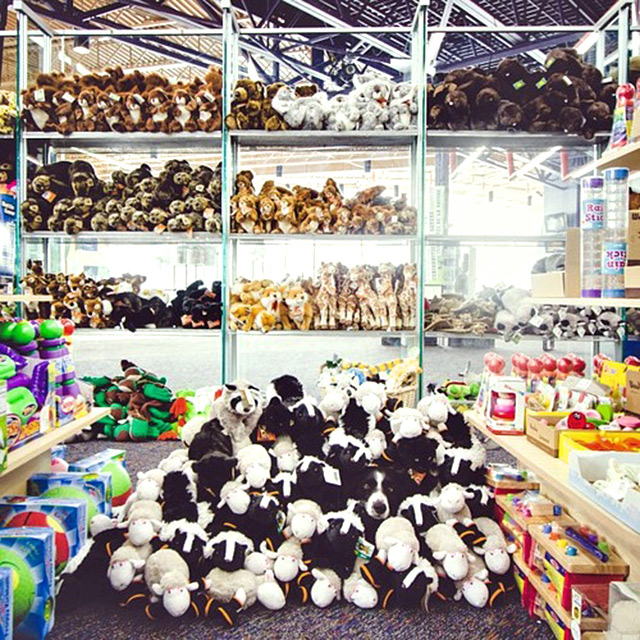 Where's Momo? Andrew Knapp regularly posts photos of his border collie playing hide and seek in and around Sudbury, Ontario, a city 400 km north of Toronto that is still recovering from more than a century of nickel mining.
Where's Momo? Andrew Knapp regularly posts photos of his border collie playing hide and seek in and around Sudbury, Ontario, a city 400 km north of Toronto that is still recovering from more than a century of nickel mining.
dog
Canada
Ontario
border collie
Sudbury
(h/t: Larry Schlesinger)
(image credit: Andrew Knapp)
Aug 14, 2013
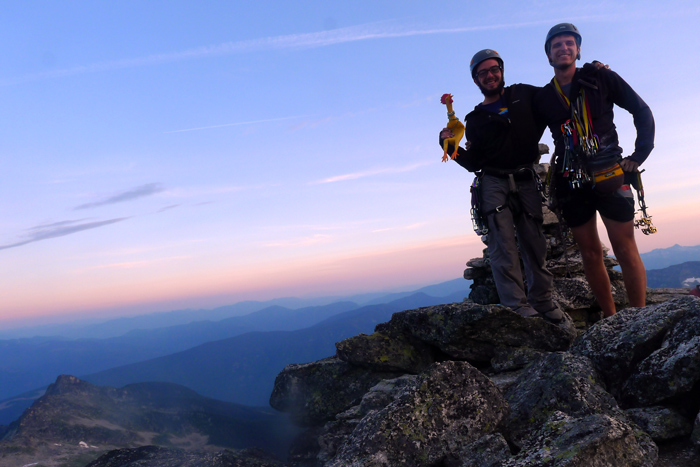 Last weekend, Hank, his climbing buddy Pat, and their other climbing buddy, the orange-footed yaller guy, summited Mount Gimli, a 9,000-foot spire of gneiss in the Valhalla Range of southeastern British Columbia.
Last weekend, Hank, his climbing buddy Pat, and their other climbing buddy, the orange-footed yaller guy, summited Mount Gimli, a 9,000-foot spire of gneiss in the Valhalla Range of southeastern British Columbia.
landscape
Canada
sunset
British Columbia
Hank
mountain
Pat
Mount Gimli
summit
Valhallas
(Image credit: Hank Stein)
Apr 9, 2016
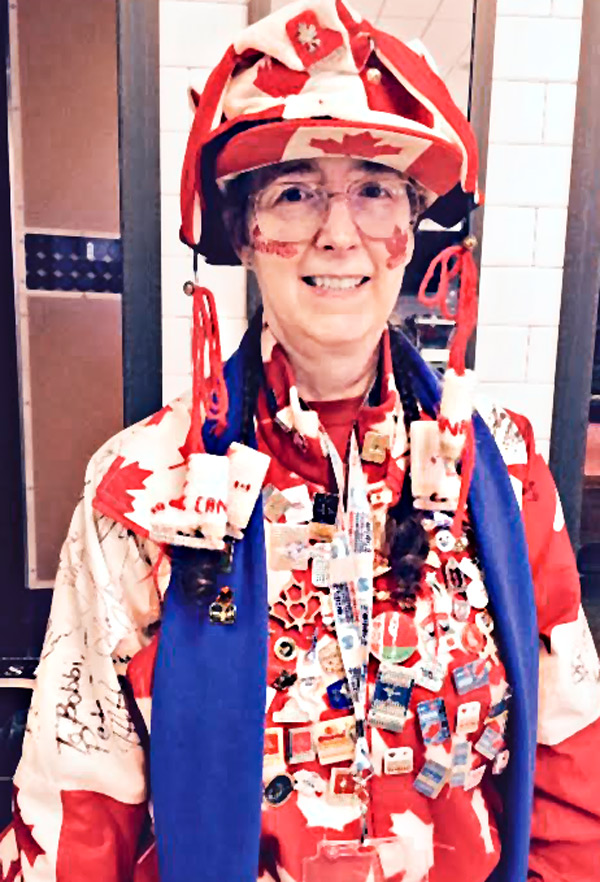
Last week saw the finals of the 2016 World Figure Skating championships, and needless to say, Bobbi Cochar was there for every minute of every program. Ever since she sat rinkside at the Canadian national championships in Ottawa in 1984, this Toronto native has never missed a major skating event, no matter where on earth the venue might be.
She cheers on her Canadians, of course, two of whom, Megan Duhamel and Eric Radford, did skate away with the gold medal last week in the pairs category. But Cochar is really there for all the skaters, making sure that every single one of them receives one of her trademark needlepoint skate ornaments as she or he goes out on the ice, along with a personal note of encouragement and thanks.
Skating looms large in Cochar's heart, especially since her diagnosis with multiple sclerosis at the age of 28. She had always been a noncompetitive dancer, and after her diagnosis, she was stunned to realize that she could still skate, even performing complicated moves and routines. "But once I was off the ice," she recalls, "I couldn't walk to save my life."
Multiple sclerosis has since cost her the hearing in one ear and the color vision in one eye, though the doctor who predicted she'd never walk again was incorrect. She skates six days a week now, four days for her work with the CanSkate program and two days on her own, just because she can.
Until recently, Cochar's mother, also a longtime ice dancer, traveled to skating events with her. The two of them collected autographs on their jackets from skaters all over the world, and took personal responsibility to make sure that anybody at all who was brave enough and hard-working enough to go out there and skate their hearts out in front of a crowd would go home with words and tokens of appreciation from skating's unrivaled superfans.
sports
Canada
Boston
Bobbi Cochar
fans
ice skating
(Image credit: Carol Fuchs)
Apr 30, 2016
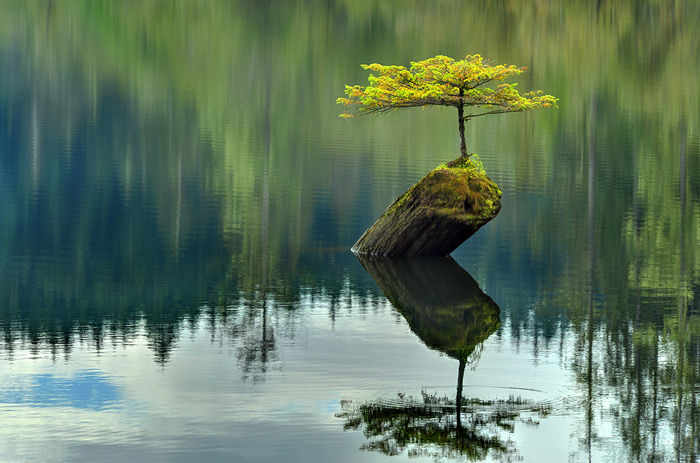 In the middle of Fairy Lake, near the remote town of Port Renfew on the west coast of Canada's Vancouver Island, sits an old Douglas fir log, partly rotting where it's exposed to the air but mostly submerged in the still waters of the lake.
In the middle of Fairy Lake, near the remote town of Port Renfew on the west coast of Canada's Vancouver Island, sits an old Douglas fir log, partly rotting where it's exposed to the air but mostly submerged in the still waters of the lake.
On the rotten tip of the log is another Douglas fir tree, alive and growing but not exactly flourishing; its roots struggle to maintain purchase on the log and to pull nutrients from the rotting wood. Without soil to grow in, it is stunted, a natural bonsai tree, starved but somehow much more interesting and impressive than all the millions of ordinary fir trees growing fat and happy where trees are meant to grow.
Canada
British Columbia
tree
Port Renfrew
Fairy Lake
Vancouver Island
bonsai
log
(Image credit: Rsvlts.com)
Feb 10, 2017

The post in the foreground marks the border between the Canadian province of Manitoba and the state of North Dakota; the farm fields in the background are in North Dakota. Last weekend, 22 refugees, mostly from Somalia, walked for miles through these fields in below-zero cold and waist-deep snow, attempting to escape the United States and find freedom in Canada.
In 2016, more than 400 refugees crossed the border here, in hopes of being granted asylum in Canada. Thousands more attempted the crossing elsewhere along the northern edge of the United States.
A common story behind this journey involves fleeing a war zone or other hellish homescape and eventually making it into the U.S., usually by way of Mexico. The refugees plead for asylum and are taken into custody; they are imprisoned for a year or more, during which time contact with their families back home is extremely limited. In fact, communication with the outside world is so limited that they find it impossible to properly prepare their asylum paperwork.
Eventually, they may be released under restrictive orders, pending an asylum decision. Their petitions are judged inadequate, their claims rejected, and they are ordered to report for deportation back to Somalia, Eritrea, Djibouti, or whatever land they had fled.
Instead, they head north. Canada and the U.S. have had a treaty since 2004 called the Safe Third Country Agreement, which basically says that refugees just get one shot at filing for asylum, either in Canada or the U.S., whichever they come to first. But the refugees argue that the U.S. isn't really a safe haven and keeps refugees locked up and unable to obtain documentation needed for their claims; Canada, they say, has a fairer system.
As long as the treaty is in effect, Canadian border agents have to turn over would-be asylum-seekers from the U.S. to U.S. agents. So the refugees can't enter Canada by road. They walk through woods or fields, or in some cases swim, across the border in between offical crossing points, and then they turn themselves in to the Royal Canadian Mounted Police.
The police call in organizations to help find housing and other support for the border-crossers. Immigrants from their homelands are contacted, to help with employment and translation. Advocate groups help with the asylum paperwork. Border towns, such as Emerson, Manitoba, the settlement closest to the fields shown here, are sometimes called on to provide emergency food and shelter.
On Christmas Eve, two men facing deportation back to Ghana, where one of them said he would be killed because he was a homosexual, paid a cab driver $400 in Grand Forks, North Dakota, to drive them to the border. The driver let them out near this field in a snowstorm, with wind chill far below zero.
For seven hours, they struggled through snowdrifts to cross the field. Only one of them had a hat; neither had gloves. When they finally crossed the border and came to a road, they spent three hours trying to flag down a passing vehicle. Finally, a truck driver stopped for them and called 911.
Both men are still in the hospital in Winnipeg, where they face amputations from severe frostbite. One has been told he will lose all his fingers and at least one toe. Still, they say, their situation is far better than it would be back in Ghana.
This refugee railroad, headed north to freedom, predates the election of Donald Trump. But there is now much greater interest in sneaking into Canada even by asylum-seekers who have not yet had their claims rejected; they fear that even if somehow they can manage to stay in the U.S., their families will never be allowed to join them.
There is also increased interest among Canadians in ending the Safe Third Country Agreement, in light of recent evidence that the U.S. can no longer be considered a safe destination for many refugees.
Canada
winter
Manitoba
immigration
refugees
journey to freedom
asylum
North Dakota
(Image credit: CBC News Manitoba)
Jan 6, 2018
 In the wintry weather currently gripping eastern North America, icy mounds of frozen spray, known as sugarloaves, are growing huge atop frozen rivers below not-quite-fully-frozen waterfalls. There's a sugarloaf at the base of Niagara Falls this year, and also one at Montmorency Falls near Québec City; the falls at Montmorency are some 98 feet higher than Niagara and are located almost a thousand kilometers to the northeast, in a climate zone where every winter is plenty cold enough to make a sugarloaf.
In the wintry weather currently gripping eastern North America, icy mounds of frozen spray, known as sugarloaves, are growing huge atop frozen rivers below not-quite-fully-frozen waterfalls. There's a sugarloaf at the base of Niagara Falls this year, and also one at Montmorency Falls near Québec City; the falls at Montmorency are some 98 feet higher than Niagara and are located almost a thousand kilometers to the northeast, in a climate zone where every winter is plenty cold enough to make a sugarloaf.
The painting shown above, The Ice Cone, by Robert Clow Todd, shows Montmorency Falls and its sugarloaf in the winter of 1845. The place looked pretty much the same when we visited, in the winter of 2004, minus the horses, of course.
Tall, cone-shaped things with slightly blunted tips are often called sugarloaves, especially if they are ski resorts or a mountain in Rio de Janeiro with a statue on top. That's because real, old-school sugarloaves–actual hard, solid loaves of refined sugar–were produced in molds shaped like that. Up until the end of the nineteenth century, when manufacturing processes emerged to refine sugar into a granulated product, people who could afford to buy white sugar–meaning rich people–bought it by the loaf, which might weigh as much as 30 or 35 pounds. They chipped off pieces as needed, using heavy, sharp-edged pliers known as sugar nips.
The sugarloaves pictured below are on display in the Sugar Museum in Berlin.
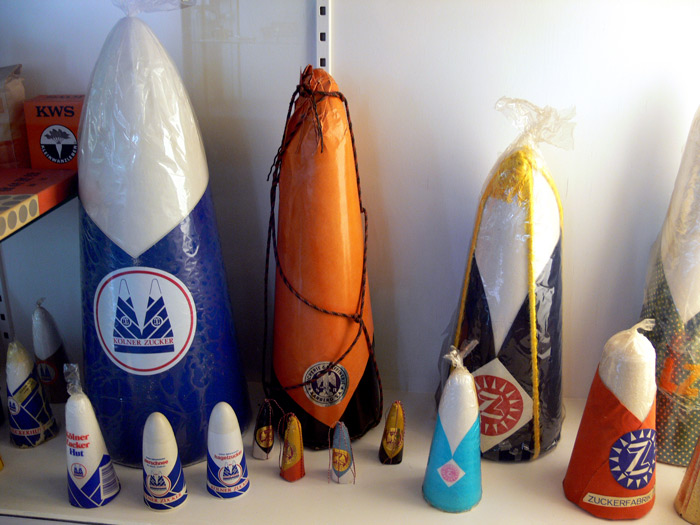
landscape
Canada
winter
snow
ice
Berlin
waterfall
Quebec
sugar
Montmorency Falls
Sugar Museum
(Art by Robert Clow Todd)
Mar 11, 2018
 The night owls who officially discovered–and named–Steve are the members of a Facebook group called Alberta Aurora Chasers. They are folks who like to stay up late and drive out to remote pastures and mountain valleys, even when the winter nights are insanely cold, which they often are in the prairies and Rockies of western Canada–all in hopes of a chance to enjoy big, unpolluted views of shimmery aurora borealis lights in the northern sky.
The night owls who officially discovered–and named–Steve are the members of a Facebook group called Alberta Aurora Chasers. They are folks who like to stay up late and drive out to remote pastures and mountain valleys, even when the winter nights are insanely cold, which they often are in the prairies and Rockies of western Canada–all in hopes of a chance to enjoy big, unpolluted views of shimmery aurora borealis lights in the northern sky.
Steve is the name the aurora chasers borrowed from the children's movie Over the Hedge and applied to a particular, somewhat unusual aurora-like phenomenon, streaks of purple light that ripple vertically from the horizon instead of dancing horizontally along it like a normal, well-behaved, aurora. Normal auroras are produced when electrons thrown off by the sun approach earth, where they are pulled by our magnetic field toward the north and south poles. As they collide with gas molecules in the upper atmosphere, they can put on a bright light show.
Steve, scientists thought at first, could be generated by protons instead of electrons crashing into our atmosphere. But a professor of physics and astronomy at the University of Calgary, Eric Donovan, suspected otherwise; proton collisions, he thought, wouldn't give off much visible light for aurora chasers to photograph and enjoy.
In 2016, Donovan was able to track down something he thought might be an instance of Steve that was picked up by a satellite flying right overhead in Alberta. So he went on Facebook and asked the Alberta Aurora Chasers if they'd seen anything that night, at that location.
They had noticed it and photographed it. Donovan correlated their photos with the satellite data and concluded that Steve wasn't technically an aurora at all; it was a ribbon of extremely hot gas flying through space, more than 3,000 degrees Fahrenheit hotter than its surroundings.
Donovan believes the Steve discovery demonstrates the potential of "citizen scientists" to leverage data from satellites and other instruments in our brave new world. Of course, it also demonstrates what happens, à la Boaty McBoatface, when digital anybodies are charged with coming up with names for stuff.
landscape
Canada
Calgary
night
astronomy
physics
Alberta
Eric Donovan
protons
electrons
aurora borealis
(Image credit: Dave Markel)












 Here we see yet another branch of the family, a cast of characters with international flair: my cousin Susan, at left, who lives near Toronto, Ontario; her daughter Erica, who is working on her doctorate in archaeology at Oxford University in England; and Susan's mother Ethel, who lives in Annapolis, Maryland.
Here we see yet another branch of the family, a cast of characters with international flair: my cousin Susan, at left, who lives near Toronto, Ontario; her daughter Erica, who is working on her doctorate in archaeology at Oxford University in England; and Susan's mother Ethel, who lives in Annapolis, Maryland.

 Very rarely do these Good Mornings feature movie stars and suchlike. So here's something different for y'all, a real celebrity, in a photo taken by Sam Javanrouh at last month's Toronto International Film Festival.
Very rarely do these Good Mornings feature movie stars and suchlike. So here's something different for y'all, a real celebrity, in a photo taken by Sam Javanrouh at last month's Toronto International Film Festival.
 Scarborough Bluffs escarpment above Lake Ontario in Toronto.
Scarborough Bluffs escarpment above Lake Ontario in Toronto.

 Tadpoles swarm amongst the lily stalks in a Canadian pond, in a photo submitted to National Geographic by Campbell River underwater photographer Eiko Jones.
Tadpoles swarm amongst the lily stalks in a Canadian pond, in a photo submitted to National Geographic by Campbell River underwater photographer Eiko Jones. Where's Momo?
Where's Momo? 





